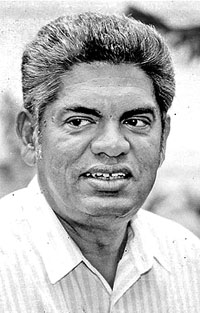Sunday Times 2
Recalling that narrow escape
One of the most unforgettable days in my life was Sunday, July 31st 1987, the day on which we almost witnessed the assassination of both our President and Prime Minister. A few days before this, the Indo- Sri Lanka Agreement had been signed between President J.R. Jayewardene and Prime Minister Rajiv Gandhi of India. Just two days later, both the President and the Prime Minister had invited the members of the UNP Parliamentary Group to meet in Committee Room 1, the largest committtee room in the Parliamentary complex.

The illustration that accompanied a Sunday Times article on the parliament bomb blast
Suddenly receiving a message that the President wanted to see me, I hesitated for a moment as this was a party meeting of the UNP MPs but since it was the Head of State summoning me I went down. I had fortunately taken a copy of the Order Paper with me and when the President asked me what the business of the House was that day, I showed him the Order Paper. He told me that he would like to address Parliament as he wanted to apprise both Government and Opposition Members of his reasons for signing the Agreement with Prime Minister Gandhi. I said that I would inform the Speaker and left the room.
Just 20 minutes later, my peon rushed into my room on the 2nd floor and said the Prime Minister wanted to see me very urgently. When I went to the ground floor, I met President Jayewardene being escorted out of the Committee Room. The room was now full of smoke and shattered glass and I was terribly shocked to see Minister Lalith Athulathmudali on a stretcher, bleeding very badly. I had fortunately got the Medical Room equipped with stretchers and an ambulance parked outside the Members entrance. At the back of the Parliamentary complex, a gate normally kept closed for security reasons was opened and the ambulance was able to take him to Sri Jayewardenapura Hospital in five minutes. I had alerted the hospital that the Minister was being brought in.

Lalith Athulathmudali
It was later that I was informed that either a bomb or a hand grenade had been thrown into the Committeee Room. The hand grenade had riccocheted off the polished table at which the two leaders sat and exploded under the Minister’s chair where he was seated in the front row with other Govt. Members , making a six-inch hole on the carpeted floor and injuring him badly.
Much later, after making a speedy recovery, the Minister told me that the person who threw the grenade was totally unaware of the drill that had to be followed. He with his wide knowledge of military and armament matters said that after pulling the pin, it was necessary to count one thousand, two thousand, three thousand, before hurling the grenade. As this was not done, the President and the Prime Minister escaped assassination.
The surgeon who operated on Minister Athulathmudali and saved his life was Dr K. Yoheswaran who was a close friend of his. He had even attended his wedding and visited him when he was working in outstation hospitals like Badulla. I knew Dr Yoheswaran well too as my late brother Dr Nissanka Seneviratne, Professor of Physiology and he had been fellow House Officers at the General Hospital many years back. Moreover my daughter Shanika had a very close friendship with Dr Yoheswaran’s daughter Dilani from their schooldays, lasting even up to date though Dilani is now domiciled in Boston, USA.
Reflecting on this incident 40 years ago, I rang Dr Yoheswaran, now 92, and asked for a date to come and have a chat with him. He readily agreed and invited me for breakfast. Still sprightly, he has an excellent memory and talked of how he had operated on Lalith that fateful morning around 11 a.m.
He told me how at the Sri Jayewardenepura Hospital, there were three surgical teams with Dr S.A.W. Goonewardane, Dr D. Ranasinghe and himself especially to cater to soldiers who had received injuries at war time and that not a single soldier had died during his surgical career. Dr Rienzie Pieris was the Hospital Chairman at the time.
Lalith had been in the OPD on the ground floor and then been moved to the operating theatre. He had recognised Dr Yoheswaran instantly. He had been given a blood transfusion but the Dr decided that immediate surgery was essential and Lalith had inquired if a local anaesthetic could be given to which he said ‘No’. Dr Suriyakanthi Amerasekera was the Anaesthetist.
The theatre had been crowded with lots of doctors.The surgery had lasted 2-3 hours as there had been multiple injuries. A colostomy operation was also done removing his spleen.
A few months later in October 1987, the Minister had proceeded to the USA for a check up to the prestigious Columbia Presbyterian Hospital in New York. A team of three medical specialists had stated that despite the serious injuries he had received, he was now in robust physical condition. Dr Alan Weiss, Consultant in Surgery had tested him from head to toe, and singled out for special mention the Consultant Surgeon who had attended on him – Dr K. Yoheswaran.
Later on, Lalith had visited Dr Yoheswaran’s home on Havelock Road and having met his mother there, thanked her profusely for her son saving his life.
( The writer is a former Secretary General of Parliament)

